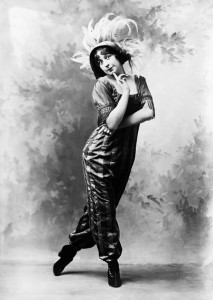When Florenz Ziegfeld, Jr. arrives New York in 1893, the intersection of Broadway and 42nd is nobody’s idea of “the crossroads of the world.” But by 1913, “The Ziegfeld Follies really were an amalgamation of everything that was happening in America, in New York, at that time,” says writer Philip Furia. “Flo Ziegfeld was like the Broadway equivalent of the melting pot itself.” Ziegfeld’s story introduces many of the era’s key figures: Irving Berlin, a Russian immigrant who becomes the voice of assimilated America; entertainers, like Jewish comedienne Fanny Brice and African American Bert Williams, who become America’s first “crossover” artists; and the brash Irish-American George M. Cohan, whose song-and-dance routines embody the energy of Broadway. This is also the story of the onset of a world war, and the Red Summer of 1919, when labor unrest sweeps the nation – and Broadway. Episode One culminates in Ziegfeld’s 1927 production of Jerome Kern and Oscar Hammerstein II’s far-sighted masterpiece, Show Boat. “The history of the American musical theater is divided quite simply into two eras: everything before Show Boat, and everything after Show Boat,” says writer Miles Kreuger.
The episode features interviews with Irving Berlin’s daughter Mary Ellen Barrett, Ziegfeld Follies girls Doris Eaton and Dana O’Connell, New Yorker critic Brendan Gill, theater artist Al Hirschfeld, composer/lyricist Stephen Sondheim, and Ziegfeld daughter Patricia Z. Stephenson. Highlights include newly-restored color footage of The Ziegfeld Follies and footage of Fanny Brice singing “My Man.”

Jimmy Durante and Ethel Merman in Red Hot and Blue. (Credit: Courtesy of Photofest)
Gossip columnist Walter Winchell gives Broadway a nickname that becomes synonymous with all of New York: “It is the Big Apple, the goal of all ambitions, the pot of gold at the end of a drab and somewhat colorless rainbow….” With the advent of Prohibition and the Jazz Age, America convulses with energy and change, and nowhere is the riotous mix of classes and cultures more dramatically on display than Broadway. “There was this period in which everybody was leaping across borders and boundaries,” says director/producer George C. Wolfe. “There was this incredible cross-fertilization, cultural appropriation.” While brash American women flapped their way to newfound freedoms, heroines of Broadway like Marilyn Miller become a testament to pluck and luck. It’s the age of “Whoopee” and the “Charleston,” Runnin’ Wild and the George White Scandals. In 1921, a jazz show like no other arrives: Shuffle Along, which features a rich, rousing score by Noble Sissle and Eubie Blake, reopening Broadway’s doors to black talent. Unique talents like the Marx Brothers and Al Jolson – a Jewish immigrant and Prohibition’s biggest star – rocket to stardom. The Gershwin brothers, the minstrels of the Jazz Age, bring a “Fascinating Rhythm” to an entire nation. Innovative songwriting teams like Richard Rodgers and Lorenz Hart ignite a new age of bright, clever lyrics with the massive hit “Manhattan.” But as the Roaring Twenties come to a close, Broadway’s Jazz Age suffers the one-two punch of the “talking picture” and the stock market crash, triggering a massive talent exodus to Hollywood and putting an end to Broadway’s feverish expansion.
The episode features interviews with actor Carol Channing, Gershwin sister Frances Gershwin Godowsky, Al Jolson & Co. creator Stephen Mo Hanan, critic Margo Jefferson, writer Miles Krueger, New Yorker theater critic John Lahr, radio host/music critic Jonathan Schwartz, theater historians Max Wilk and Robert Kimball, and director/producer George C.Wolfe. Highlights include rare performance footage of composer Eubie Blake and a specially animated sequence of Rodgers and Hart’s 1927 hit “Thou Swell” from A Connecticut Yankee.
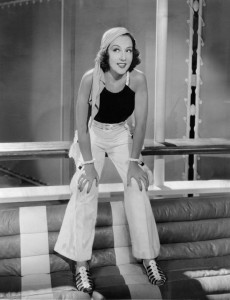
Ethel Merman in a scene from Anything Goes, 1934. (Credit: Courtesy of Photofest)
The Great Depression proves to be a dynamic period of creative growth on Broadway, and a dichotomy in the musical theater emerges. Productions like Cole Porter’s Anything Goes offer glamour and high times as an escape, while others – such as Of Thee I Sing, which satirizes the American political system, and the remarkable WPA production of The Cradle Will Rock, about a steel strike – deal directly with the era’s social and political concerns. When Bing Crosby records “Brother, Can You Spare a Dime,” the doleful Broadway ballad takes the hit parade by surprise. “This song spoke to the hearts, and to the minds, and to the emotions and thoughts, of everybody who lived during that Depression,” says lyricist Yip Harburg’s son, Ernie. Rodgers and Hart return to New York to create a string of new shows, including the sexually frank Pal Joey, a genuine departure that stars newcomer Gene Kelly. In the gloom of the Depression, Porter offers Broadway audiences such unforgettable songs as “You’re the Top,” which serves as an effervescent tonic to a weary nation. In 1935, George Gershwin creates his epic masterpiece, Porgy and Bess, which becomes, in the words of one critic, “the most American opera that has yet been seen or heard.” The onset of World War II galvanizes the country and America’s troubadour, Irving Berlin, rallies the troops with This Is the Army.
The episode features interviews with actor and original “Bess” Anne Brown, playwright Jerome Chodorov, actor Carol Channing, film director Stanley Donen, actor and original “Porgy” Todd Duncan, writer Philip Furia, actor Kitty Carlisle Hart, actor June Havoc, actor/producer John Houseman, actor/director Tim Robbins, and composer/lyricist Stephen Sondheim. Highlights include rarely seen home movies of the Gershwin brothers from the 1930s, and 1950s TV footage of the incomparable Ethel Waters singing Irving Berlin’s “Suppertime.”
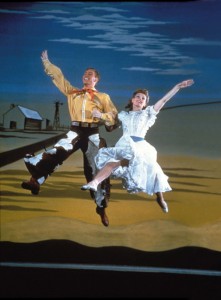
Mark Platt and Katharine Sergava in a scene from Oklahoma, 1943. (Credit: Courtesy of Gjon Mili/Getty Images)
The new partnership of Richard Rodgers and Oscar Hammerstein II changes the face of Broadway forever, beginning with the record-breaking Oklahoma! in 1943, featuring a landmark ballet by Agnes De Mille. Carousel and South Pacific then set the standard for decades to come by pioneering a musical where story is all-important. For challenging the country to confront its deep-seated racial bigotry, South Pacific wins the Pulitzer Prize. In On the Town, an exuberant team of novices – Leonard Bernstein, Betty Comden, Adolph Green, and Jerome Robbins – capture the energy, humor and pathos of New York City during World War II. Irving Berlin triumphs again with Annie Get Your Gun, featuring Ethel Merman and the unofficial anthem of the American musical theater, “There’s No Business Like Show Business.” In shows like Guys and Dolls, My Fair Lady and Kiss Me, Kate, sophisticated adaptations of literary material prevail. “Cole Porter led the way in writing adult songs about love and sex,” says theater historian Robert Kimball. “He defied the censors. He, probably more than any other songwriter in this century, made it possible for the openness that we have in all popular music.” In 1956, Alan Jay Lerner and Frederick Loewe triumph with My Fair Lady, featuring a 20-year-old Julie Andrews. TV’s The Ed Sullivan Show becomes the most important showcase for Broadway musicals. Yet with the death of Oscar Hammerstein II soon after the premiere of The Sound of Music in 1959, the curtain begins to lower on a golden age.
The episode features interviews with actor Julie Andrews, writer/lyricist Betty Comden, choreographer Agnes De Mille, writer/lyricist Adolph Green, Oscar Hammerstein’s grandson Andy Hammerstein, choreographer Michael Kidd, author James Michener, theater historian Steve Nelson, musician John Raitt, choreographer Jerome Robbins, composer Mary Rodgers Guettel, and conductor Michael Tilson-Thomas. Highlights include never-before-broadcast footage of Jerome Robbins’ choreography for On the Town, 1960 TV footage of Rex Harrison re-enacting “I’m an Ordinary Man” from My Fair Lady, and the first American broadcast of 1950 footage of the original Guys and Dolls cast performing in London.
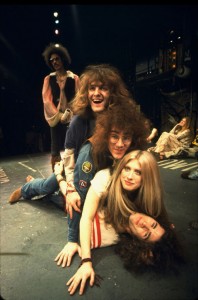
Scene from the musical Hair, 1968. (Credit: Courtesy of Martha Swope)
West Side Story not only brings untraditional subject matter to the musical stage, it ushers in a new breed of director/choreographer who insists on performers who can dance, sing and act. But by the time Jerome Robbins’ last original musical, Fiddler on the Roof, closes after a record run of 3,242 performances in 1972, the world of Broadway has changed forever. Rock ‘n’ roll, civil rights and Vietnam usher in new talents, many trained by the retiring masters, taking musical theater in daring new directions with innovative productions like Hair, the first Broadway musical with an entire score of rock music. The non-linear narrative of George Furth and Stephen Sondheim’s Company plunges the musical into a new era. Hal Prince’s conceptual staging showcases John Kander and Fred Ebb’s dynamic score for Cabaret. Bob Fosse captures a sexuality and cynicism ahead of its time with Chicago, but it is director/choreographer Michael Bennett who spearheads the biggest blockbuster of all – A Chorus Line. “It totally changed the musical theater,” says Shubert Organization chairman Gerald Schoenfeld. “It was a catalyst for the improvement of this area, and of course this area is now the most desirable area in New York.” With Sondheim’s Sweeney Todd, the Broadway musical reaches unexpected new heights in style and material with a tale of slaughter and cannibalism set in 19th-century London. By the end of the 1970s, Broadway becomes the centerpiece of a remarkably successful public relations campaign that will lure tourists to New York for years to come.
The episode features interviews with actor Joel Grey, composer Marvin Hamlisch, actor Jerry Orbach, producer Hal Prince, writer Frank Rich, lyricist Stephen Sondheim, director Julie Taymor, and actor Ben Vereen. Highlights include rare footage of Ethel Merman rehearsing for Gypsy and home movies from the original stage production of Chicago.
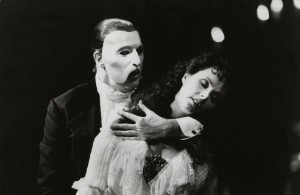
Michael Crawford and Sarah Brightman in The Phantom of the Opera, 1988. (Credit: Courtesy of Photofest)
Legendary as the “Abominable Showman,” notorious producer David Merrick re-conquers Broadway in 1980 with a smash adaptation of the movie musical 42nd Street. But soon the biggest hits are arriving from an unexpected source – London. Producer Cameron Mackintosh redefines the business of show business as Cats, Les Misérables, The Phantom of the Opera, and Miss Saigon become international blockbusters. James Lapine lures Stephen Sondheim off-Broadway to develop Sunday in the Park With George, while Jerry Herman’s crowd-pleasing La Cage aux Folles has two men sing a love song to each other for the first time on Broadway. The AIDS crisis decimates Broadway. With Julie Taymor’s triumphant re-imagining of The Lion King, Disney leads an astonishing resurrection of 42nd Street. Composer Jonathan Larson scores a bittersweet victory with the rock-flavored Rent, and the old-style musical is reborn in Mel Brooks’ The Producers, which becomes the first must-see musical comedy in decades, fetching a ticket price of $480 for each VIP seat. After 9/11, Broadway – like the rest of America – emerges from the darkness. Broadway’s corporate dominance continues to grow, as evidenced by new shows such as Wicked, the biggest hit of the 2003-04 season. “Oh, I’ve been hearing about Broadway disappearing ever since I put on long pants,” says the illustrator Al Hirschfeld. “I mean, it’s been the fabulous invalid. You know, but it survives, it survives.”
The episode features interviews with writer/producer Mel Brooks, actor Kristin Chenoweth, Walt Disney Corporation CEO Michael Eisner, actor/bookwriter Harvey Fierstein, composer/lyricist Jerry Herman, actor Nathan Lane, playwright/director James Lapine, producer Rocco Landesman, director Arthur Laurents, actor Idina Menzel, Nederlander Theaters chairman James Nederlander Sr., director Susan Stroman, and composer Andrew Lloyd Webber. Highlights include home movies of Jonathan Larson working as a waiter before leaving his job to create Rent, and exclusive behind-the-scenes footage of Wicked in rehearsal and opening on Broadway.

